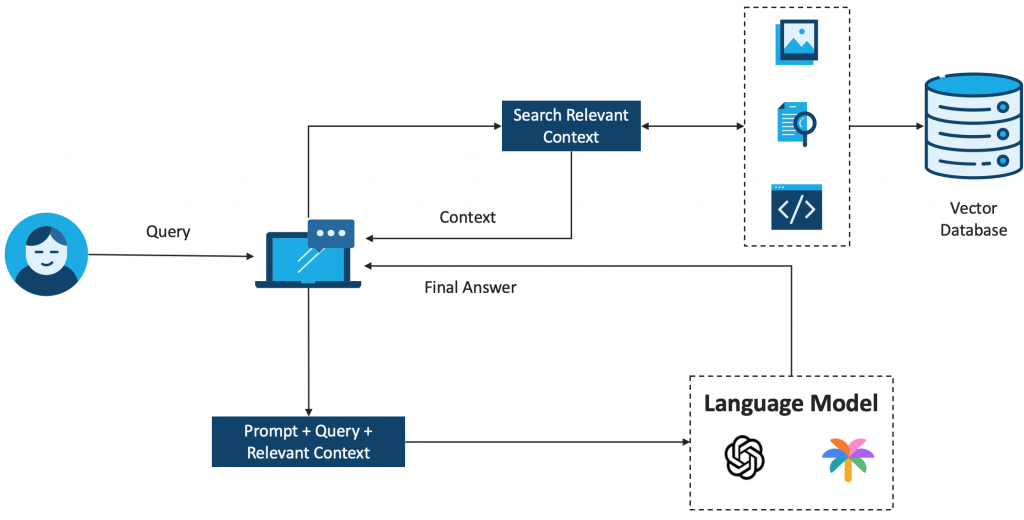Introduction
Retrieval-Augmented Generation (RAG) is an innovative approach to Generative AI and natural language processing. This technique combines the power of information retrieval with advanced language generation models to enhance the capabilities of Generative AI models. At its core, RAG involves retrieving relevant information from a large dataset and then using the same to generate informed, accurate, and contextually appropriate responses.
The Importance of Retrieval-Augmented Generation
The significance of Retrieval-Augmented Generation lies in its ability to bridge the gap between vast information repositories and generate meaningful, context-aware content. Traditional language models, while powerful, often operate with limited context, relying solely on their pre-trained knowledge and the immediate input provided. RAG extends this capability by actively pulling in external data, enabling the model to provide more relevant, detailed, and up-to-date responses. This is particularly useful in scenarios where the context constantly evolves or the model needs a reference to specific, factual information that wasn’t included in its original training data.
Benefits of Retrieval-Augmented Generation
- Enhanced Accuracy and Relevance – By incorporating external data sources, RAG systems can produce responses that are not only contextually accurate but also highly relevant to the current state of knowledge in a particular domain. This is especially important in fields like medicine, law, and technology, where staying up-to-date with the latest information is crucial
- Improved Context Understanding – RAG allows AI models to have a broader understanding of context by accessing a vast array of information sources. This leads to responses that are more nuanced and aware of the broader context surrounding a query or topic
- Dynamic Response Generation – The dynamic nature of RAG enables AI systems to adapt their responses based on the most current and relevant information available, making them more effective in real-time applications
How Retrieval-Augmented Generation Works
Retrieval-augmented generation (RAG) is a sophisticated process that enhances the interaction between a user’s query and the generation of a relevant response. The process can be broken down into several key stages,
- Query Initiation – Everything starts with a query, which is a question or request from the user that needs to be addressed by the system
- Contextual Search – Upon receiving the query, the system searches for relevant context. This involves processing the text of the query and converting it into a form that is amenable to computational search techniques, such as vector representations

- Vector Database Querying – The transformed query is then used to search a vector database. This database contains vast information encoded as vectors, which are mathematical representations of data that can be compared and matched efficiently. The system uses algorithms like cosine similarity to find the vectors that are closest to the query vector, indicating the most relevant context
- Language Model Synthesis – With the relevant context identified, the system then leverages a language model. This model, often a highly advanced neural network like those based on the transformer architecture, takes the prompt (the original query) and the retrieved context to synthesize a response. The language model is capable of understanding the nuances of both the query and the context to generate a coherent and contextually rich answer
- Response Generation – Finally, the language model outputs a generated response. This response is crafted to address the user’s query by incorporating and synthesizing the information retrieved in the previous steps
The methodology described above for Retrieval-Augmented Generation (RAG) is just one approach among many. RAG is inherently flexible, allowing various implementations to accommodate diverse applications and data types. Alternative systems may not necessarily use vector databases; they might employ different data structures or retrieval mechanisms, such as bespoke databases tailored for specific content or alternative matching algorithms like machine learning classifiers or keyword searches. The essence of RAG lies in its blend of retrieval with generation, enabling AI to deliver informed responses by tapping into a broader knowledge base beyond its intrinsic training.
Conclusion
Retrieval-augmented generation represents a significant leap in the capabilities of AI systems. By combining the power of information retrieval with advanced language generation, RAG opens up new possibilities for creating AI systems that can provide more accurate, relevant, and context-aware responses. As this technology continues to evolve, it will undoubtedly play a pivotal role in the advancement of AI and its applications across various domains.





